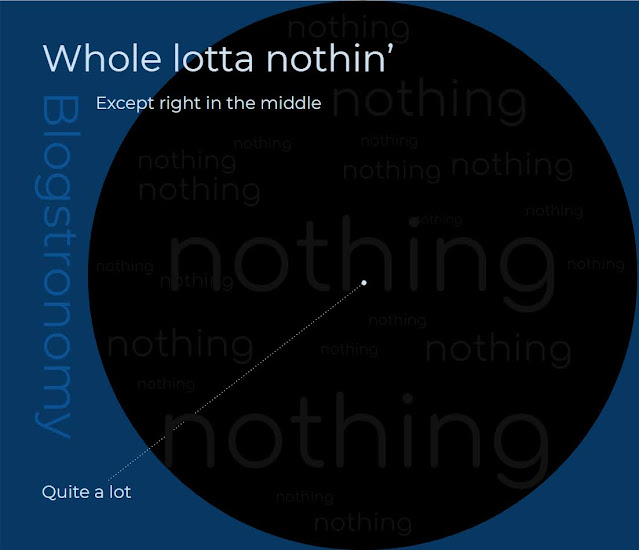What's Inside a Black Hole?
Question posed by Daniel, who is six and absolutely bonkers about physics. This might be a little ahead of where he's got to so far, but it'll just give him something to work towards, right?
The answer to this question is all three of "nothing," "quite a lot actually," and "we don't know."

|
| Whole Lotta Nothin' by T. Briggs is licensed under CC BY-NC-SA 4.0 |
We know a fair bit about black holes, such as where they come from, what would happen if you fell into one, and whether humans could make one. We know these things because we can explore them. Not literally, of course (and you wouldn't be able to tell anyone if you did manage it), but we can explore them using a massively useful tool that every member of the human race has available: mathematics.
Lots of people have mathematically prodded the equations that govern black holes, but if we wanted to pick one person to thank for everything we know so far it would probably be Einstein. His theory of General Relativity was published in 1915 and since then many a scientist has tested its predictions against observations of the real universe. Over a hundred years later it still stands strong against the best efforts of mathematical physicists to break it.
Everything and Nothing
The "small enough space" is defined by something that has become known as the "Schwarzschild radius". Every amount of mass has one of these - even you! Your personal Schwarzschild radius defines the size of the sphere that you would have to be packed down into to become a black hole. My Schwarzschild radius, at a chunky 91kg is about 0.0000000000000000000000001 metres, which is really small1 so it's not likely to happen by accident. Or even on purpose. But theoretically I could become a black hole.

|
| Anything Can Become a Black Hole by T. Briggs is licensed under CC BY-NC-SA 4.0 |
Anyway, if I did manage to squeeze the mass that makes up me into a sphere that small the effects described by Einstein's equations would kick in. The forces that stop atoms from collapsing in on themselves would be overcome by the force of gravity and it would, according to the equations, become a singularity: something which is so small that it is infinitely small and no longer has any size at all!
Right at the centre of our own galaxy, the Milky Way, there is a supermassive black hole. It contains the mass of more than four million Suns. The Schwarzschild radius of that much mass is about 12 million kilometres, which is about 17 times the radius of the Sun A sphere with that radius would have about 5000 times the volume of the Sun. Imagine that! The mass of four million Suns squashed into the space taken up by only 5000 of them. That's got to be pretty tightly packed.
It's worse: That sphere, 17 times the radius of our Sun, is not packed to the brim with matter: according to Einstein's theories all that matter is packed down into an infinitely small point at the centre of the black hole. It's not even big enough to be called a "speck": It has no size at all.
So most of what's inside a black hole is nothing at all. Between that singularity at the centre and the distance that we call the Schwarzschild radius is absolutely nothing. Well, there may well be stuff2 falling in, but that'll be in the singularity in almost no time at all.
So what is the Schwarzschild radius? Some sort of boundary fence, with warning signs up? Nope. There's no physical barrier there, no line to cross. You wouldn't notice anything as you crossed it3. It's just a theoretical boundary which defines how close we can get to a black hole and still have a chance of going home again. Once you get pass a black hole's schwarzschild radius there is, very literally, no going back.
But then again...
We don't know
We cannot know what, exactly, is inside a black hole. When Einstein's theories suggest a singularity what they're really telling us is that we've reached a point at which the laws of physics as we understand them completely break down. The theories which describe so much of the universe so well just stop working here, and many believe that this may be because the universe itself stops playing by its own laws in these situations. It may be that we must discover an entirely new form of mathematics to truly understand what goes on inside black holes; it may also be that this will forever be beyond our abilities.

|
|
|
Footnotes
- It's about one millionth of the wavelength of an ultra-high-energy gamma ray.
- Including light. But you wouldn't see much, and not just because you'd be dead by then. If, by some miracle, you had survived and could look around you wouldn't see anything in the direction you were falling, towards the singularity, because everything that went in before you would be accelerating away from you faster than the speed of light. If you looked "up", back the way you'd come you wouldn't see anything because you would be accelerating away from anything that fell in after you, also faster than the speed of light.
- Even if you'd survived that far, which you wouldn't.



Hello, can you publish a post on what happen if we fall into a Black hole because i need some information about this and can you give some suggestion about on my post similar to this topic :- https://www.space-knowledge.in/2020/07/Black-holes-2020-ultimate-Guide.html if possible then please give dofollow backlink to my site i have already given you a backlinks from my site thanks.
ReplyDelete